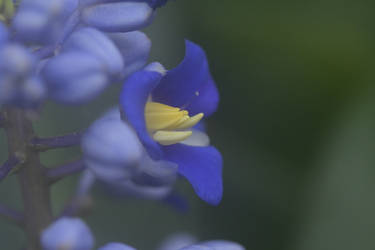ShopDreamUp AI ArtDreamUp
Deviation Actions
Suggested Deviants
Suggested Collections
You Might Like…
Featured in Groups
Description
Familia: Commelinaceae
Nombre común: Hierba de pollo, tripa de pollo, hierva de agua, monte de agua, canutillo.
Clasificación: Hoja ancha.
Hábitat: Es común en cultivos, rastrojos y pastizales. Lugares húmedos y sombreados favorecen el crecimiento de esta planta.
Planta: Es suculenta, perenne y postrada a ascendente. Los tallos son ramificados y producen raíces adventicias en los nudos; usualmente es glabroso. Las raíces son fibrosas.
Hojas: Son similares a las de las gramíneas, lanceoladas a ovadas, glabrosas, con ápice agudo o acuminado, redondeado en la base. La vaina es cerrada, delgada, transparente, seca y membranosa. Mide de 1-1.5 cm de largo.
Inflorescencia: Se presenta en cimas axilares. El pedúnculo es de 1-5 cm de largo. La bráctea es ovada-lanceolada, aguda o acuminada, verde, glabrosa y algunas veces ciliada en la base. Presenta racimos de 1-3 flores, con tres pétalos azules, siendo los dos superiores más largos que el inferior. El fruto es una cápsula normalmente con cinco semillas de color negro y reticuladas.
Otros: Una planta puede producir alrededor de 1,000 semillas; se propaga también vegetativamente. El ganado se puede alimentar de esta planta. Puede ser útil en las plantaciones de café porque protege el suelo de la erosión; también es usada como planta medicinal. Es hospedera de los nematodos Pratylenchus y Melodogyne y del hongo Phytium que causa la pudrición de las raíces del frijol.
Family: Commelinaceae
Common name: Chicken grass, chicken gut, water boil, mound of water, canutillo.
Classification: Broad leaf.
Habitat: It is common in crops, stubble and grasslands. Humid and shady places favor the growth of this plant.
Plant: It is succulent, perennial and prostrate to ascendant. The stems are branched and produce adventitious roots in the knots; Usually it is glabrous. The roots are fibrous.
Leaves: They are similar to grasses, lanceolate to ovate, glabrous, with apex acute or acuminate, rounded at the base. The sheath is closed, thin, transparent, dry and membranous. It measures 1-1.5 cm long.
Inflorescence: It occurs in axillary tops. The peduncle is 1-5 cm long. The bract is ovate-lanceolate, acute or acuminate, green, glabrous and sometimes ciliated at the base. It has clusters of 1-3 flowers, with three blue petals, the upper two being longer than the lower one. The fruit is a capsule usually with five seeds of black color and reticulated.
Others: A plant can produce about 1,000 seeds; It also propagates vegetatively. Cattle can be fed from this plant. It can be useful in coffee plantations because it protects the soil from erosion; It is also used as a medicinal plant. It is host of the Pratylenchus and Melodogyne nematodes and the Phytium fungus that causes the bean root rot.
Nombre común: Hierba de pollo, tripa de pollo, hierva de agua, monte de agua, canutillo.
Clasificación: Hoja ancha.
Hábitat: Es común en cultivos, rastrojos y pastizales. Lugares húmedos y sombreados favorecen el crecimiento de esta planta.
Planta: Es suculenta, perenne y postrada a ascendente. Los tallos son ramificados y producen raíces adventicias en los nudos; usualmente es glabroso. Las raíces son fibrosas.
Hojas: Son similares a las de las gramíneas, lanceoladas a ovadas, glabrosas, con ápice agudo o acuminado, redondeado en la base. La vaina es cerrada, delgada, transparente, seca y membranosa. Mide de 1-1.5 cm de largo.
Inflorescencia: Se presenta en cimas axilares. El pedúnculo es de 1-5 cm de largo. La bráctea es ovada-lanceolada, aguda o acuminada, verde, glabrosa y algunas veces ciliada en la base. Presenta racimos de 1-3 flores, con tres pétalos azules, siendo los dos superiores más largos que el inferior. El fruto es una cápsula normalmente con cinco semillas de color negro y reticuladas.
Otros: Una planta puede producir alrededor de 1,000 semillas; se propaga también vegetativamente. El ganado se puede alimentar de esta planta. Puede ser útil en las plantaciones de café porque protege el suelo de la erosión; también es usada como planta medicinal. Es hospedera de los nematodos Pratylenchus y Melodogyne y del hongo Phytium que causa la pudrición de las raíces del frijol.
Family: Commelinaceae
Common name: Chicken grass, chicken gut, water boil, mound of water, canutillo.
Classification: Broad leaf.
Habitat: It is common in crops, stubble and grasslands. Humid and shady places favor the growth of this plant.
Plant: It is succulent, perennial and prostrate to ascendant. The stems are branched and produce adventitious roots in the knots; Usually it is glabrous. The roots are fibrous.
Leaves: They are similar to grasses, lanceolate to ovate, glabrous, with apex acute or acuminate, rounded at the base. The sheath is closed, thin, transparent, dry and membranous. It measures 1-1.5 cm long.
Inflorescence: It occurs in axillary tops. The peduncle is 1-5 cm long. The bract is ovate-lanceolate, acute or acuminate, green, glabrous and sometimes ciliated at the base. It has clusters of 1-3 flowers, with three blue petals, the upper two being longer than the lower one. The fruit is a capsule usually with five seeds of black color and reticulated.
Others: A plant can produce about 1,000 seeds; It also propagates vegetatively. Cattle can be fed from this plant. It can be useful in coffee plantations because it protects the soil from erosion; It is also used as a medicinal plant. It is host of the Pratylenchus and Melodogyne nematodes and the Phytium fungus that causes the bean root rot.
Image size
5355x3345px 5.31 MB
Make
SONY
Model
DSLR-A230
Shutter Speed
1/80 second
Aperture
F/10.0
Focal Length
55 mm
ISO Speed
100
Date Taken
Jan 16, 2015, 10:30:31 AM
Sensor Size
32mm
© 2016 - 2024 Jimmasterpieces
Comments15
Join the community to add your comment. Already a deviant? Log In
its gorgeous 



































